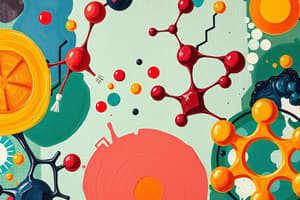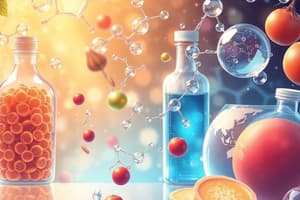Podcast
Questions and Answers
What are examples of proteoglycans mentioned in the text?
What are examples of proteoglycans mentioned in the text?
hyaluronic acid, chondroitin sulfate, heparin
What is the main characteristic of glycoproteins?
What is the main characteristic of glycoproteins?
- Have structurally complex oligosaccharides (correct)
- Main components of the extracellular matrix
- Contain many GAG chains
- Are proteins found in interstitial connective tissues
What are glycolipids carbohydrate-lipid conjugates where the oligosaccharide is attached to the lipid moiety through a ______ residue or an alcohol?
What are glycolipids carbohydrate-lipid conjugates where the oligosaccharide is attached to the lipid moiety through a ______ residue or an alcohol?
hexosamine
Match the following blood types with their corresponding transferase enzymes:
Match the following blood types with their corresponding transferase enzymes:
What are the functions of carbohydrates?
What are the functions of carbohydrates?
How many major classes of carbohydrates are there?
How many major classes of carbohydrates are there?
Glucose is the most important monosaccharide in nature.
Glucose is the most important monosaccharide in nature.
Aldose monosaccharides contain an ________ group.
Aldose monosaccharides contain an ________ group.
Match the following ring structures with the correct monosaccharide:
Match the following ring structures with the correct monosaccharide:
Which sugar alcohol can accumulate in tissues such as the lens, sciatic nerve, and renal papillae in disorders like diabetes mellitus and galactosemia?
Which sugar alcohol can accumulate in tissues such as the lens, sciatic nerve, and renal papillae in disorders like diabetes mellitus and galactosemia?
What is the main clinical use of Mannitol in patients?
What is the main clinical use of Mannitol in patients?
Humans can digest cellulose due to the presence of specific enzymes.
Humans can digest cellulose due to the presence of specific enzymes.
What kind of link is present between alpha-glucose units in Dextran? Dextran consists of α-glucose units linked by ______________ bonds.
What kind of link is present between alpha-glucose units in Dextran? Dextran consists of α-glucose units linked by ______________ bonds.
Match the following sugar derivatives with their roles:
Match the following sugar derivatives with their roles:
Study Notes
Carbohydrates
- General characteristics:
- Many have the empirical formula (C(H2O)n, n ≥ 3
- Some contain N, P, or S
- Are polyhydroxy aldehydes or ketones, or substances that yield such compounds on hydrolysis
- Functions:
- Energy/storage
- Structural and protective elements
- Lubricate skeletal joints
- Recognition and adhesion between cells
Classification of Carbohydrates
- Three major classes:
- Monosaccharides: Consist of a single polyhydroxyaldehyde or ketone unit
- Oligosaccharides: Consist of 2-20 monosaccharides covalently linked by glycosidic bonds
- Polysaccharides: Polymers consisting of chains of monosaccharide or disaccharide units (>20)
Monosaccharides
- Characteristics:
- Simplest of the carbohydrates
- Either aldehydes or ketones, with two or more -OH groups
- Colorless and crystalline solids; freely soluble in water but insoluble in non-polar solvents
- Most have a sweet taste
- Most monosaccharides of >4 C's tend to have cyclic structures
- Examples:
- Glucose, Fructose, Galactose, Mannose, and Ribose
Glucose
- Most abundant monosaccharide in nature
- Mainly absorbed from the diet; converted to other carbohydrates having specific functions
- Major fuel for certain mammalian tissues
- Converted to other carbohydrates, such as glycogen, nucleic acids, and galactose
Other Monosaccharides
- Mannose: A subunit in glycoproteins and neuraminic acid
- Galactose: A subunit of the milk sugar, lactose
- Fructose: The sweetest sugar, found in honey and fruits
- D-Ribose: A component of RNA, DNA, ATP, GTP, and coenzymes
- D-glyceraldehyde and dihydroxyacetone: Aldehydo- and keto-trioses, respectively, that are intermediary compounds in carbohydrate and lipid metabolism
Isomerism in Carbohydrates
- D- and L-isomerism: Determined by the orientation of the —H and —OH groups around the carbon atom adjacent to the terminal alcohol carbon
- D-sugars are metabolizable, while L-sugars are not
- Optical isomerism: Refers to the ability of a sugar solution to rotate plane-polarized light
- Fructose is the L(-) isomer, while Glucose and Galactose are the D(+) isomers
Anomers
- α-anomer: The -OH on C1 is on the opposite side of the ring from the -CH2OH
- β-anomer: The -OH on C1 is on the same side of the ring as the -CH2OH
Pyranose and Furanose Ring Structures
- Pyranose: A six-membered ring
- Furanose: A five-membered ring
Chemical Properties of Monosaccharides
- Susceptibility to oxidation: Can be oxidized to sugar acids
- Susceptibility to reduction: Can be reduced to sugar alcohols
Sugar Alcohols (Polyols)
- Formed when the carbonyl group of the monosaccharide is reduced to a hydroxyl group
- Examples:
- Sorbitol (D-glucitol)
- Mannitol
- Inositol (a hexahydric cyclic sugar alcohol)
- Uses:
- As a dietary substitute for sugar
- In the manufacture of diabetic-friendly foods
- As a sweetener and flavoring agent
Sugar Derivatives
- Amino sugars: Contain an amino group instead of a hydroxyl group
- Deoxy sugars: Contain a hydrogen instead of a hydroxyl group
- N-acetyl derivatives: Contain an N-acetyl group instead of a hydroxyl group
Glycosides
- N- and O-glycosidic bonds: Formed when the hydroxyl group on the anomeric carbon of a monosaccharide reacts with an –OH or an –NH group of another compound
- Examples:
- Adenosine (a nucleoside)
- Glycoproteins
Disaccharides
-
Formed from two monosaccharides units covalently bonded together by glycosidic linkages
-
Examples:
- Maltose (α(1→4) glycosidic linkage between two Glc residues)
- Lactose (Gal(β1→4)Glc)
- Sucrose### Disaccharides
-
Sucrose is a disaccharide of glucose and fructose
-
It is a non-reducing sugar with an α1 → 2β glycosidic link between the anomeric carbon hydroxyls of both glucose and fructose
-
Its chemical structure is α-D-Glucopyranosyl-(1→2)-β-D-fructofuranoside
Polysaccharides
- Polysaccharides differ from each other in the identity of their recurring monosaccharide units, length of their chains, types of bonds linking the units, and degree of branching
Homopolysaccharides
- Starch is a homopolymer of glucose connected by alpha-glycosidic bonds
- It is the most common ingested dietary polysaccharide, found in vegetables and cereals
- Starch is 80% amylopectin (branched) and 20% amylose (non-branched)
- It is a storage polysaccharide in plant cells
- Glycogen is a homopolymer of glucose, more highly branched and with shorter branches
- It is the main storage polysaccharide of animal cells
- Cellulose is a homopolysaccharide of β-glucose in β 1, 4 linkage
- It is the chief constituent of plant cell walls, insoluble, and a major component of dietary fiber
- Humans lack enzymes that hydrolyze β 1, 4 glycosidic bonds, so they cannot digest cellulose
- Dextran is a highly branched meshwork glucosan composed of α-glucose units linked by α-1,4, α-1,3, and α-1,6-glucosidic linkages
- Therapeutic applications of dextran include:
- Forming a colloidal solution in water, used as a plasma substitute to restore blood pressure in cases of hemorrhagic shock
- Dextran ferrous sulfate, used for intramuscular injection of iron for treatment of iron deficiency anemia
- Sodium dextran sulfate, an anticoagulant
- Inulin is a homopolysaccharide of fructose in β 2 → 1 linkage
- It is found in onions and garlic, belongs to a class of fibers, and is readily soluble in water
- Inulin is not hydrolyzed by human digestive enzymes and is used in physiological investigations for determining glomerular filtration rate (Inulin clearance test) and estimating total body water
Heteropolysaccharides
- Heteropolysaccharides have repeating units of two or three monosaccharides
- They generally contain an amino-sugar and a uronic acid
- They are also known as mucopolysaccharides
- Functions of heteropolysaccharides include:
- Providing shape and extracellular support for cells and tissues
- Acting as lubricants
- Mediating cell-cell interactions
- Acting as biological anti-coagulants and anti-freeze agents
- Serving as receptors for hormones
Glycosaminoglycans
- Glycosaminoglycans are unbranched heteropolysaccharide chains composed of disaccharide repeat units
- One sugar of the disaccharide is either N-acetylglucosamine or N-acetylgalactosamine, and the second is usually acidic (either glucuronic acid or uronic acid)
- These sugars are modified by the addition of sulfate groups to the parent sugar
- Glycosaminoglycans are major components of the extracellular matrix
- Examples include hyaluronic acid, chondroitin sulfate, and heparin
Proteoglycans
- Proteoglycans are proteins that contain many chains of glycosaminoglycans
- They occur by a core trisaccharide, Gal-Gal-Xyl
- Proteoglycans are found in interstitial connective tissues, such as the synovial fluid of joints, the vitreous humor of the eye, arterial walls, bone, cartilage, and cornea
- They are major components of the extracellular matrix in these tissues
Glycoproteins
- Glycoproteins contain covalently linked oligosaccharides that are smaller but more structurally complex than glycosaminoglycans
- Many cell surface or extracellular proteins are glycoproteins, as are most secreted proteins
- The covalently attached oligosaccharides influence the folding and stability of the proteins, provide critical information about the targeting of newly synthesized proteins, and allow for specific recognition by other proteins
Glycolipids
- Glycolipids are carbohydrate-lipid conjugates where the oligosaccharide is attached to the lipid moiety through a hexosamine residue or an alcohol, such as sphingosine
- Bacterial cell wall lipopolysaccharides and the human ABO blood group cell membrane antigens are important examples
- The ABO blood group antigens are formed of 3-4 sugar residues branched-side-chain connected to the RBCs surface ceramide or connected to a plasma secretory glycoprotein in some individuals
- Both the RBCs membrane-bound and the serum glycoprotein-bound ABO blood antigens are used as individual-specific fingerprints in forensic criminal investigations
Studying That Suits You
Use AI to generate personalized quizzes and flashcards to suit your learning preferences.
Description
This quiz covers the basics of carbohydrates, including their empirical formula, composition, and various functions in the body.




